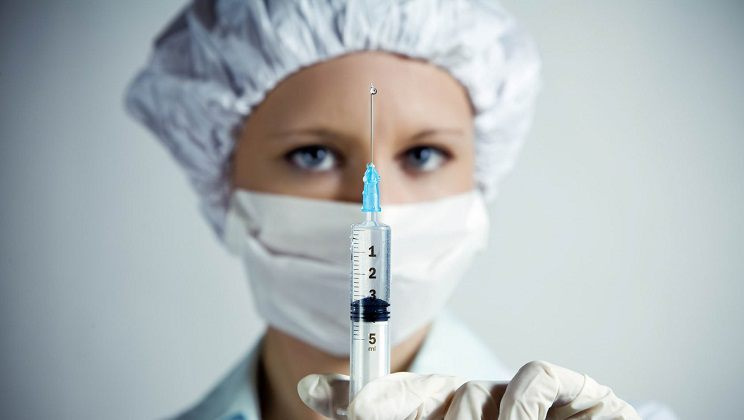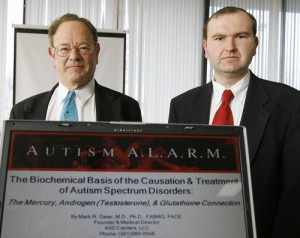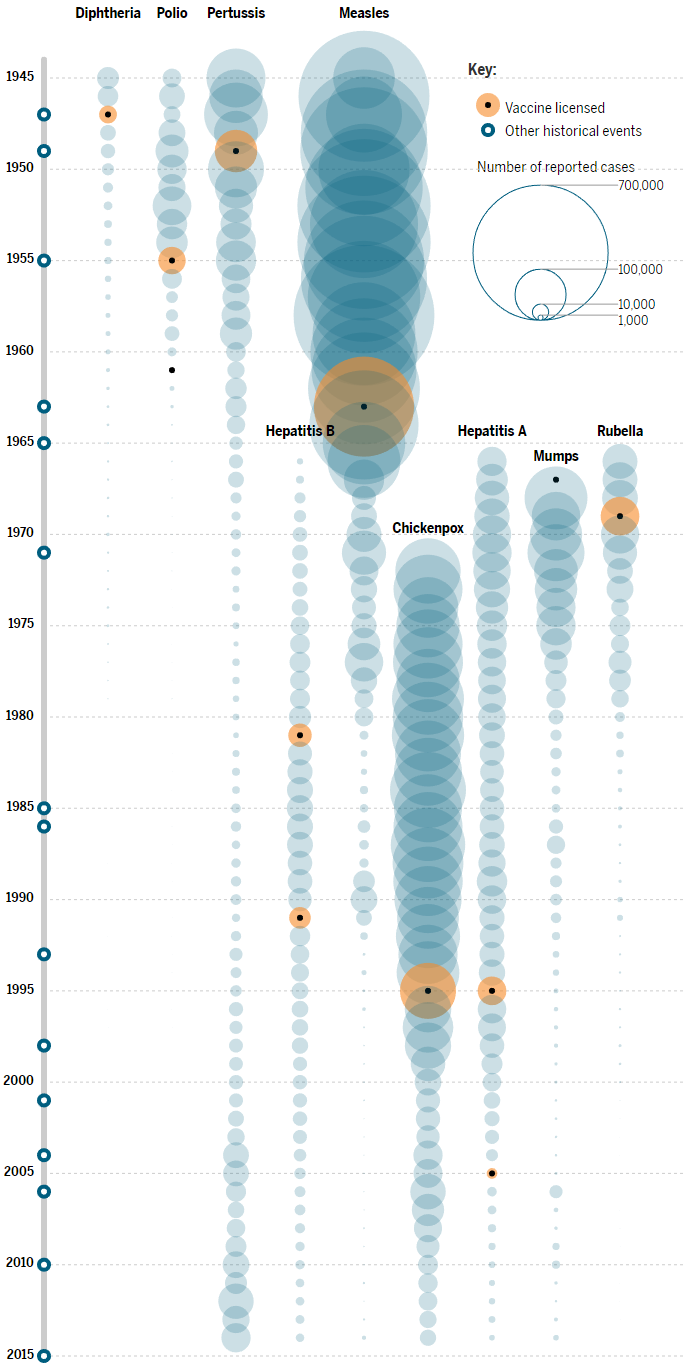This is Science: 4 common vaccination myths and their roots

A source
Science Magazine magazine continues to delight with excellent materials. This time two wonderful articles caught my eye. One of them is devoted to the myths surrounding the vaccination of children. The other, using infographics, perfectly demonstrates how the invention and introduction of vaccines over the course of the 20th century helped defeat a wide variety of diseases or significantly reduce mortality from them.
Briefly about terms
The term vaccine (or vaccination) is used to describe a drug that stimulates the production of an immune response for a particular disease. In other words, a vaccine is a trip to a fitness center for the immune system.
If primitive and simplifying to a certain extent, then vaccines are different in nature:
')
- alive when a harmless pathogen is planted on a person and the immune system learns to coexist with it (rubella, measles, tuberculosis, etc.)
- “Killed” when grown virus strains, for example, deactivate, but the envelope remains with receptor proteins, to which, often, a temporary response of the immune system is produced (influenza)
- chemical, both synthesized and biotechnologically specific antigens obtained
Each vaccine goes a long way from basic scientific research and ideas to practical application and clinical practice. Since in the future the vaccine will be used on a large population of people, they are trying to make it as harmless as possible and take into account all side effects.
So let's begin the legend of myths.
Myth One: Vaccination can trigger autism.
In 1988, the English doctor Andrew Wakefield (Andrew Wakefield) published a paper in the journal The Lancet , where he suggested that the vaccine against measles, mumps and rubella (Diamax or MMR in Western countries) could trigger autism. Literally a year later, the share of vaccinated among two-year-old children in England fell below 80% (!). It took more than 15 years before journalist Brian Dean (Brain Deen) discovered the so-called " conflict of interest " in 2004. It turned out that Wakefield himself filed a patent application for his own vaccine against the diseases mentioned. In addition, he also received money from lawyers who tried to sue the companies that produce the MMR vaccine.

Andrew Wakefield himself. A source
Omitting a long history of scandal, it should be noted that in the end, The Lancet only withdrew the article in 2010. And shortly thereafter, the United Kingdom’s General Medical Council permanently took the license to practice medicine from the “doctor”.
However, the myth resurfaced in 2016 with the release of the film “Vaxxed”, shot under the guidance of Wakefield himself. The film points to data harboring by the Centers for Disease Control and Prevention (CDC).

Never was and here again! (with)
For fans of REN-TV:
Meanwhile, in 2014, the two largest ever MMR data analysis published in Vaccine (meta-data analysis of 1.3 million people) and the Journal of the American Medical Association (comparing several thousand vaccinated and unvaccinated children) showed complete failure Wakefield statements.
RESULT: No connection between the occurrence of autism in children and Diavax vaccine (MMR) on a large sample of the population (read - small statistical error) was NOT detected. Point.
Myth Two: Mercury in vaccines acts like a neurotoxin.
In 2005, Rolling Stone and Salon published the story of one respected lawyer in American circles, President Kennedy’s nephew, Robert F. Kennedy Jr. ( Robert F. Kennedy Jr. ). He argued that the government was hiding the facts of the negative impact on the brain and the central nervous system of the drug thiomersal (thiomersal). Including the use of thiomersal can lead to autism. This mercury-containing preparation has been used for some time as a preservative for vaccines.

A source
A lot of denials and hints of distorting facts followed very quickly. In particular, Kennedy in his story incorrectly indicated the levels of mercury content. After all, the toxicity of the drug directly depends on this, as Paracelsus said: “Everything is poison, the question is only in dose”. In 2011, Salon magazine still removed this note from the site.
However, Kennedy continued his struggle in promoting this idea. Recently, his supporters, skeptical of vaccines, even announced the Vaccine Safety Commission , led by Kennedy. However, according to both the Centers for Disease Control and Prevention and WHO, there is no convincing evidence that thiomersal in the doses taken in vaccines causes problems in children.
The structure of Thiomersal. A source
On the other hand, thiomersal was removed from disposable vaccines for children several years before the publication of Kennedy’s article and book. It remained only in reusable vaccines (many patients are vaccinated from one bottle) of use, such as, for example, against influenza, where this preservative is simply necessary. As Frank DeStefano, Director of the Immunization Safety Department of the above-mentioned CDC, rightly noted: “If this drug would cause autism, stopping its use immediately resulted in a reduction in the number of patients with the disease, which we, unfortunately, do not observe.”
The rumor that the incidence of autism declined in Denmark after refusing to use thimerosal in vaccines in 1992 is also not true. It appears to have originated from the misinterpretation of epidemiological data.
RESULT: There is simply no undeniable evidence of the harm of mercury-containing "preservatives" for vaccines in the concentrations in which they are used.
Myth three: combating mercury in vaccines can make children healthier
In the mid-2000s, on the wave of horrors about thiomersal harm, doctor from Maryland Mark Geier and his son David Geier began to unleash the theory that the pathological interaction between mercury and testosterone (a male sex hormone) can explain many symptoms autism. This conclusion was made on the basis of several works published by the Geiers themselves, which according to the Institute of Medicine have “serious methodological flaws”. However, this did not embarrass the "researchers" and they continued to treat as they considered necessary.

Father and son - "fighters" for freedom from mercury-containing drugs. A source
Geira used an unproven "treatment" technique that consisted of daily injections of Lupron , a substance that, for a second, is used for chemical castration and in chemotherapy for prostate cancer. Children are prescribed this drug in exceptional cases of early puberty (up to 8 years), when it is necessary to suppress excessive production of sex hormones, and can cause many side effects: bone diseases, heart problems, seizures, which may be a sign of autism, and so on.

Chemical structure of Lupron. A source
Not only did Geyer prescribed unjustified and expensive (more than $ 5000 per month) treatment, they also made incorrect diagnoses and directly misled the parents of children. As a result of the trial, the license was taken away from Geyer, and his son was punished with a fine for illegally practicing medical practice without a proper education.
From myself, I note that the mercury in the thiomersal molecule is bound, this time, and the compound itself is a water-soluble salt, this is two, while in the fat-soluble testosterone molecule there are only two oxygens that can potentially “interest” the mercury. However, mercury complexes with oxygen have problems with stability and are quite difficult to obtain. Thus, firstly, it is generally difficult for these molecules to interact, and secondly, it’s not particularly why (there is no thermodynamic driving force).
RESULT: The self-rule of doctors and hysteria around unconfirmed data on the use of vaccines can only exacerbate the situation.
The fourth myth: “stretching” the vaccination calendar may be safer for children.
Some vaccination skeptics are trying to fight the well-established vaccination schedule, when the child should be vaccinated against 14 major diseases before the age of two. The argument is very simple: too much chemistry in such a short period of time, as a result - an overload of the immune system. They are still deeeeeeeetochki! (c) Skeptics argue that this overload predetermines the development of many diseases, including delays in the development of the nervous system and diabetes, while experts completely refute these, in fact, conjectures.

One of the examples is not the most "aggressive" alternative vaccine calendar. A source
According to the CDC, the child’s immune system must deal with thousands of foreign antigens daily, while the vaccination schedule recommended in 2014 “forces” the child to develop an immune response to only ~ 300 specific antigens for two years. Paul Offit, an expert on vaccines from the Children's Hospital of Philadelphia in Pennsylvania, performed a rough mathematical calculation of the 11 major vaccinations that a baby will take in two years. The result is only 0.1% of the “spent” immune system of the child. Although the number of recommended vaccines has increased in recent years, progress in vaccine development means that the number of antigens contained in these vaccines has decreased. At the same time, the rates of spread of, for example, autism and diabetes remain at the same level.
In a survey of 534 pediatricians and family doctors conducted in 2015, published in the journal Pediatrics , only about 1% agreed that the vaccination schedule should be extended. But almost all of them sometimes succumbed to parental requests for a prolonged vaccination schedule, and some doctors even suggested “alternative” vaccination schemes. “However, alternative vaccine schedules pose many problems,” says Offit. The most obvious: “stretching” the graphics leaves children vulnerable to dangerous diseases longer. Delaying vaccines also increases the likelihood that children will not receive all of their vaccinations. For example, one of the proposed alternative schedules would require as many as 19 visits to a doctor over 6 years - 12 of them before the age of two years. “A greater number of visits increases the burden on parents and ultimately puts children in danger of catching any disease from sick patients in the foster care,” says Offit.
Two words about western medicine
From myself, I note that in Western countries (using the example of Switzerland), a bill for visiting a doctor is set based on the number of points (scores) for admission and the specific value of each unit. Each procedure, whether it is an examination, an injection, an analysis, or any intervention, has its own regulated points, and the payment may vary depending on the qualifications and experience of the doctor. Therefore, it is more profitable for doctors to have the patient go more often, which is hidden behind a friendly smile, conversations about the weather and “health care”.
RESULT: Follow the established vaccination schedule, which has already been tested on a multi-million sample of the world's population. Do not experiment.
Infographics: the usefulness of vaccination with one picture
The most delicious I reserved for dessert. About why vaccination is necessary and important, dry figures of statistics of the USA convincingly speak. As soon as one or another vaccine received the necessary documents and was put into practice, an immediate decrease in the incidence rate of 1-2 years followed.

On the Science Magazine website, the data are given in an interactive form: in particular, you can find out what year and how many people suffered from a particular disease in the period from 1945 to 2015.
Instead of conclusion
Trust the visual statistics and reliable data that says that vaccination has saved and is saving our human civilization from the banal extinction during epidemics. Do not believe the myths and rumors, even if they are expressed by quite respected people (for example, Kennedy's nephew). And adhere to the recommendations of the attending physician, and if you think that something is going wrong, go to an appointment with another specialist in the same field.
Remember, your health and the health of your loved ones are in your hands!
The original articles, “Four vaccine myths where they came from” and “Here's the best proof of harm,” were published in the journal Science Magazine .
PS: Do not forget to subscribe , and write about the defects noted in the text in the LAN.
PPS: The other day I earned my channel in Telegram - you are welcome;)
Source: https://habr.com/ru/post/404047/
All Articles